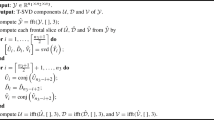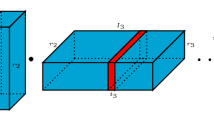Abstract
Although tensor completion theory performs well with high data missing rates, a lack of attention is encountered at the level of data completion non-negative constraints, and a remaining lack of effective non-negative tensor completion methods is still found. In this article, a new non-negative tensor completion model, based on the low-rank tensor completion theory, called the Nonnegative Weighted Low-Rank Tensor Completion (NWLRTC) method, is proposed. Due to the advantages of Truncated Nuclear Norm (TNN) in low-rank approximation, NWLRTC considers the TNN as the objective optimization function and adds a directional weight factor to the model to avoid its dependency on the data input direction. In addition to considering the completion accuracy, NWLRTC also imposes non-negativity constraints to meet the requirements of practical engineering applications. Finally, NWLRTC is realized by the alternating direction multiplier method. As for the experiments, they are carried out using different methods for generating missing data and for different iteration times. The experimental results show that the NWLRTC algorithm has high completion accuracy at low missing data rates, and it maintains a stable completion accuracy even when the missing rate hits 80%.








Similar content being viewed by others
Data availability
1. The Numerical data analysed during the current study are available in the Dataset Open Access repository, https://github.com/sysuits/urban-traffic-speed-dataset-Guangzhou.
Cited in the reference [32] of the manuscript.
2. The Image data analysed during the current study is available in the Dataset Open Access. http://tianqi.moji.com/liveview/picture/72181397.
Cited in the reference [10] of the manuscript.
3. The datasets generated during the current study are included in the manuscript.
References
Atif SM, Qazi S, Gillis N (2019) Improved SVD-based initialization for nonnegative matrix factorization using low-rank correction. Pattern Recogn Lett 122:53–59
Bengua JA, Phien HN, Tuan HD et al (2017) Efficient tensor completion for color image and video recovery: Low-rank tensor train[J]. IEEE Trans Image Process 26(5):2466–2479
Bin R, Li S, Jian Z, Yang C, Huachun T (2016) Using Tensor Completion Method to Achieving Better Coverage of Traffic State Estimation from Sparse Floating Car Data.[J]. PLoS One 11:7
Chen X, Sun L (2021) Bayesian Temporal Factorization for Multidimensional Time Series Prediction[J]. IEEE Trans Pattern Anal Mach Intell 99:1
Chen B, Sun T, Zhou Z et al (2019) Nonnegative tensor completion via low- rank Tucker decomposition: model and algorithm[J]. IEEE Access 7:95903–95914
Chen X, Yang J, Sun L (2020) A nonconvex low-rank tensor completion model for spatiotemporal traffic data imputation[J]. Transp Res Part C: Emerg Technol 117:102673
Chen X, Lei M, Saunier N et al (2021) Low-rank autoregressive tensor completion for spatiotemporal traffic data imputation[J]. IEEE Trans Intell Transp Syst 129:103226
Gillis N (2020) Nonnegative matrix factorization[M]. Society for Industrial and Applied Mathematics
Guo X, Yao Q, Kwok J (2017) Efficient sparse low-rank tensor completion using the Frank-Wolfe algorithm[C]//Proceedings of the AAAI Conference on Artificial Intelligence. 31(1)
Jingnan (2017) The static image of a road section in http://tianqi.moji.com/liveview/picture/72181397[DB]
Kolda TG, Bader BW (2009) Tensor decompositions and applications. SIAM Rev 51(3):455–500
Li Q, Tan H, Wu Y et al (2020) Traffic flow prediction with missing data imputed by tensor completion methods[J]. IEEE Access 8:63188–63201
Liu J, Musialski P, Wonka P et al (2013) Tensor completion for estimating missing values in visual data[J]. IEEE Trans Pattern Anal Mach Intell 35(1):208–220
Liu C, Shan H, Chen C (2020) Tensor p-shrinkage nuclear norm for low-rank tensor completion[J]. Neurocomputing 387:255–267
Morison G (2020) Sure based truncated tensor nuclear norm regularization for low rank tensor completion[C]//2020 28th European Signal Processing Conference (EUSIPCO). IEEE, 2021: 2001–2005. Saeedi T, Rezghi M. A novel enriched version of truncated nuclear norm regularization for matrix completion of inexact observed data[J]. IEEE Transactions on Knowledge and Data Engineering
Nie T, Qin G, Sun J (2022) Truncated tensor Schatten p-norm based approach for spatiotemporal traffic data imputation with complicated missing patterns[J]. Transp Res Part C: Emerg Technol 141:103737
Pan J, Gillis N (2019) Generalized separable nonnegative matrix factorization[J]. IEEE Trans Pattern Anal Mach Intell 43(5):1546–1561
Phan AH, Cichocki A (2011) Extended HALS algorithm for nonnegative Tucker decomposition and its applications for multiway analysis and classification[J]. Neurocomputing 74(11):1956–1969
Qiao H (2015) New SVD based initialization strategy for non-negative matrix factorization. Pattern Recogn Lett 63:71–77
Ran B, Tan H, Yuankai W, Jin PJ (2016) Tensor based missing traffic data completion with spatial–temporal correlation[J]. Phys A: Stat Mech Appl 446:54–63
Sinha TK, Naram J, Kumar P (2022) Nonnegative Low-Rank Tensor Completion via Dual Formulation with Applications to Image and Video Completion. Proceedings of the IEEE/CVF Winter Conference on Applications of Computer Vision
Sjölund J, Bankestad M (2022) Graph-based Neural Acceleration for Nonnegative Matrix Factorization[J]. arXiv preprint arXiv:2202.00264
Song Y, Li J, Chen X et al (2020) An efficient tensor completion method via truncated nuclear norm[J]. J Vis Commun Image Represent 70:102791
Tan H, Feng G, Feng J et al (2013) A tensor-based method for missing traffic data completion[J]. Transp Res Part C Emerg Technol 28:15–27
Tan H, Yuankai W, Feng G, Wang W, Ran B (2013) A New Traffic Prediction Method based on Dynamic Tensor Completion[J]. Procedia Soc Behav Sci 96:2431–2442
Tsitsikas Y, Papalexakis EE (2020) NSVD: Normalized Singular Value Deviation Reveals Number of Latent Factors in Tensor Decomposition[J]. Big Data 8(5):412–430
Tucker LR (1966) Some mathematical notes on three-mode factor analysis[J]. Psychometrika 31(3):279–311
Wahlberg B, Boyd S, Annergren M et al (2012) An ADMM Algorithm for a Class of Total Variation Regularized Estimation Problems[C]. 83–88
Wang X et al (2019) A Probabilistic Tensor Factorization Approach to Detect Anomalies in Spatiotemporal Traffic Activities. 2019 IEEE Intelligent Transportation Systems Conference (ITSC). IEEE
Wu Q, Zhang L, Cichocki A (2014) Multifactor sparse feature extraction using convolutive nonnegative tucker decomposition[J]. Neurocomputing 129:17–24
Xc A, Zh A, Ls B (2019) A Bayesian tensor decomposition approach for spatiotemporal traffic data imputation[J]. Transp Res Part C: Emerg Technol 98:73–84
Xinyu C et al (2018) Urban Traffic Speed Dataset of Guangzhou, China. https://github.com/sysuits/urban-traffic-speed-dataset-Guangzhou[DB]
Xu Y (2015) Alternating proximal gradient method for sparse nonnegative Tucker decomposition[J]. Math Program Comput 7(1):39–70
Xu M et al (2019) Anomaly detection in road networks using sliding-window tensor factorization. IEEE Trans Intell Transp Syst 20(12):4704–4713
Yin W, Ma Z (2019) LE & LLE Regularized Nonnegative Tucker Decomposition for clustering of high dimensional datasets[J]. Neurocomputing 364:77–94
Zheng YB, Huang TZ, Ji TY et al (2019) Low-rank tensor completion via smooth matrix factorization[J]. Appl Math Model 70:677–695
Zhou G, Cichocki A, Zhao Q et al (2015) Efficient nonnegative tucker decompositions: Algorithms and uniqueness[J]. IEEE Trans Image Process 24(12):4990–5003
Zhou W et al (2019) A multi-source-based coupled tensors completion algorithm for incomplete traffic data imputation. 2019 11th International Conference on Wireless Communications and Signal Processing (WCSP). IEEE
Acknowledgments
This work is supported by the National Natural Science Foundation of China (No. 6200238).
Author information
Authors and Affiliations
Corresponding author
Ethics declarations
Competing interests
The authors declare that they have no known competing financial interests or personal relationships that could have appeared to influence the work reported in this paper.
Additional information
Publisher’s note
Springer Nature remains neutral with regard to jurisdictional claims in published maps and institutional affiliations.
Rights and permissions
Springer Nature or its licensor (e.g. a society or other partner) holds exclusive rights to this article under a publishing agreement with the author(s) or other rightsholder(s); author self-archiving of the accepted manuscript version of this article is solely governed by the terms of such publishing agreement and applicable law.
About this article
Cite this article
Zhao, Y., Tuo, M., Zhang, H. et al. Nonnegative low-rank tensor completion method for spatiotemporal traffic data. Multimed Tools Appl (2023). https://doi.org/10.1007/s11042-023-15511-w
Received:
Revised:
Accepted:
Published:
DOI: https://doi.org/10.1007/s11042-023-15511-w




